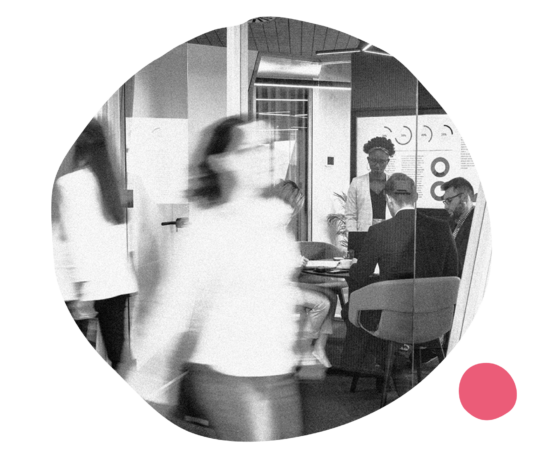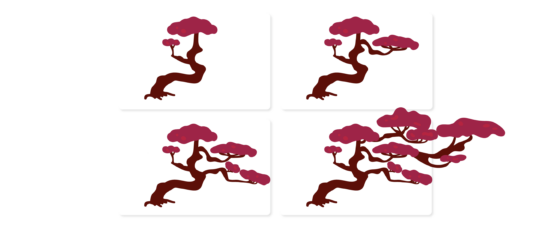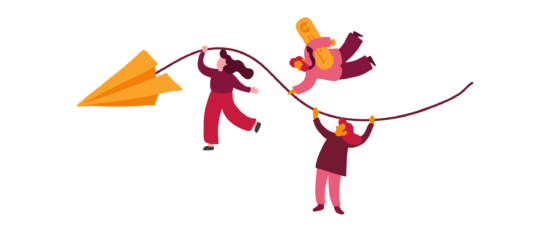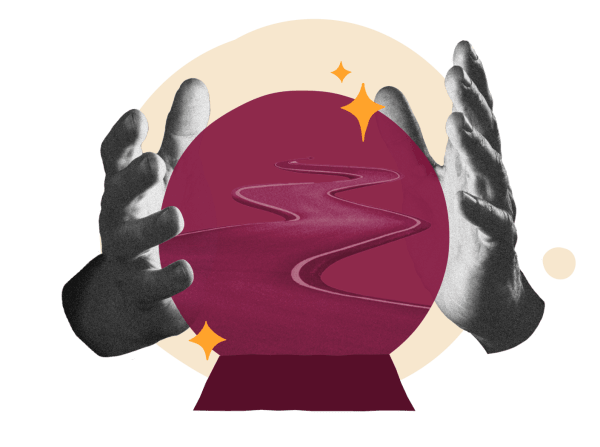Is stability history?
After the pandemic, the Great Resignation, and a wave of global and political change, it can feel like the comfortable stability that we once took for granted is getting further out of reach.
This sense of unpredictability is sweeping across every industry. Even the future of AI and its impact on us all remains uncertain. Leading experts are struggling to reach a consensus on what AI will look like in five or 10 years.
Without a clear picture of the future, are traditional change management models that rely on a fixed end goal still relevant? If not, what can HR leaders replace them with?
Toby Hough (Senior People and Culture Director at HiBob) addressed these questions in his presentation at the 2024 CIPD Festival of Work. He examined traditional change management models and provided an answer that entails a different approach altogether.
<<Embrace change. Empower your team. Download our guide for a future-proof workforce.>>

Traditional change management models
Hough asks, “Is the traditional change management notion still fit for purpose?”
While traditional change management models may have worked in the past, they fall short in environments where the future is increasingly unpredictable.
Let’s take a closer look at the different change management models and their ability to adapt to uncertainty.
Lewin’s Change Management Model
Lewin’s classic model involves three steps known as unfreeze, change, and refreeze. This is analogous to melting ice, reshaping it, and letting it solidify in a new form.
The key flaw in this model is its underlying assumption: that once the change is complete, you can lock in a stable “new normal.”
In today’s environment, however, there is no stable endpoint. Constant shifts mean that freezing into a new state simply isn’t feasible. The focus on achieving a fixed outcome makes this model increasingly irrelevant when we can’t confidently predict what the future holds.
Kotter’s 8-Step Model
Like Lewin’s approach, Kotter’s Eight-Step Model builds on the idea that once you navigate change, you can settle into a stable future state.
It emphasizes steps like creating urgency, building a coalition, and generating short-term wins, all while moving toward a defined goal.
But in a world of constant disruption, that defined goal is often a moving target, which can lead to false expectations of stability.
McKinsey 7-S Framework
The McKinsey 7-S Framework is a model for aligning various organizational elements—like strategy, structure, and systems—during a transformation. Its focus is helping large organizations coordinate these different components to move toward the desired change.
However, again, the model assumes that it’s possible to align these components to achieve a stable future. It’s a change management framework that doesn’t easily adapt to ongoing shifts that require constant re-evaluation.
ADKAR Change Management Model
ADKAR is a change management model that recommends that individuals change to bring about organizational change.
ADKAR stands for:
- Awareness of the need to change
- Desire to take part and promote the change
- Knowledge of how to change
- Ability to carry out that change
- Reinforcement to maintain the change
Because of its practical intentions, the model’s linear approach is suited to straightforward changes with clear outcomes, not the ambiguous, shifting realities that businesses now face.

Nudge Theory
Nudge Theory encourages change through small, behavior-driven adjustments and instinctive choices rather than top-down mandates.
While this model is effective for gradual culture shifts or behavioral tweaks, it lacks the urgency for more significant transformations.
Bridges Transition Model
The Bridges Transition Model excels at addressing the emotional and psychological side of change. It involves three stages:
- Endings. Where people identify what they’re losing and learn how to manage it.
- The neutral zone. The liminal space where the old paradigm is gone but the new changes aren’t fully in swing yet.
- New beginnings. Where there is certainty and movement toward the newly established direction.
Even though it’s a helpful framework for managing people’s responses, it’s still founded on the assumption that there’s a set direction to go toward.
With the reality of constant change, organizations that use this approach will need to carry out the stages repeatedly. The model doesn’t quite work in an environment where continual adaptability is a necessity.
Kübler-Ross Change Curve
With its origins in the five stages of grief, the Kübler-Ross Change Curve helps leaders understand and manage emotional resistance during major transitions.
However, like the Bridges Transition Model, it’s more focused on helping people cope with change rather than driving the agility required by today’s unpredictable world.
Satir Change Management Model
Similarly, the Satir Change Management Model maps out a journey from resistance to acceptance during change, rooted in family therapy principles.
While it’s a model that’s useful for helping individuals understand and cope with change, it doesn’t provide a framework to implement that change effectively in a world of instability.
Maurer’s 3 Levels of Resistance to Change
Rick Maurer’s model breaks resistance into three levels—lack of understanding, emotional pushback, and mistrust.
It’s a model that recognizes that change happens by engaging key stakeholders. By better understanding stakeholders’ process of resistance to change, you can use strategies to convince them to get on board with the change.
While the model helps overcome resistance, it doesn’t necessarily inspire proactive innovation or adaptability in an evolving environment.
PDCA Cycle
Like Nudge Theory, the PDCA (Plan-Do-Check-Act) Cycle focuses on making incremental changes, making it ideal for quality management.
The benefit of the PDCA Cycle is that it focuses on continuous improvement, which is more suited to the ever-changing nature of business today. However, in an era where change often needs to happen simultaneously across different areas, the PDCA cycle can feel too slow and rigid to respond effectively.
The only constant now is change
In a world where stability remains elusive, traditional change management approaches that aim for a fixed future state no longer align with today’s reality.
The goal is to no longer “manage” change as a temporary phase but to recognize that constant change is the environment in which we now operate.
This means that for organizations to thrive in today’s world, their leaders must prepare their people for unceasing change, helping them adapt and pivot continuously.
It’s about cultivating a culture where adaptability is embedded in everything you do. Successful organizations empower their people to navigate change confidently, not by promising stability, but by nurturing resilience, flexibility, and a proactive mindset.

How to set your people up to face change
Even though change is the only constant, Hough recalls how an AI expert shared with him that “the pace of change we’re experiencing today is the slowest it will ever be.”
If that’s the case, isn’t change management more important now than ever?
The problem, Hough says, is that traditional change management methodologies rely on the expectation that we know what the future state will be and that “when we finish the change management, the plane will land and we’ll get back to that period of stability. And I think that’s a really dangerous promise to make right now. I think it’s exhausting.”
Adopting the expectations that are the foundation of these approaches to change management will mean that your teams will constantly wait for a promised moment of stability that will never come.
Instead of relying on traditional change models that emphasize a clear endpoint, it’s important for today’s leaders to focus on building a change-ready culture within their organizations.
A culture where leaders provide their people with the information, tools, and support that allow them to embrace the unknown, get excited about it, and excel—no matter what comes next—is fundamental to thriving in our constantly changing world.
<<Embrace change. Empower your team. Download our guide for a future-proof workforce.>>

The scale-up journey
For early-stage startups, the path to growth is rarely linear.
Instead, it’s a twisting, unpredictable journey where pivots are the norm rather than the exception. As businesses scale, the original vision often evolves, sometimes drastically, requiring teams to adapt quickly and embrace constant change as a way of life.
Hough uses HiBob as an example. When the company first launched, the original idea centered on creating a tech platform for auto-enrollment pensions. Before even reaching the development stage, the team realized that market needs had shifted. So, they pivoted to focus on a global people platform and continually evolved as new challenges and opportunities arose.
Thriving in a scale-up environment isn’t about sticking to a rigid plan—it’s about maintaining flexibility and a willingness to shift gears whenever it’s necessary.
“The way to get through that change is not to fixate on a specific view of what the future looks like, but rather to think about those bigger-picture ideas and outcomes,” says Hough.
Successful startups aren’t those that avoid change, but those that recognize it as a constant companion and an opportunity for growth. Setting teams up for this kind of journey requires a mindset that embraces uncertainty and views each pivot as a chance to innovate and move forward.

So, where are we headed?
We can’t deny it: Change is the new norm. And it’s brought with it a host of challenges for organizations to navigate while still preparing for more unpredictable changes to come.
The arrival of Gen Z in the workforce has been a large part of the recent tidal wave of change.
Unlike previous generations who often sought stability and long-term career paths, Gen Z professionals challenge the status quo. They’re pushing for workplaces that prioritize flexibility, mental health, and purpose over rigid hierarchies and outdated structures.
As they increasingly fill leadership roles, their influence is reshaping workplace culture. With Gen Alpha set to enter the workforce in the near future, we can expect this trend to accelerate, demanding that organizations rethink what success and stability really mean.
Adding to the complexity, global economic uncertainty and geopolitical tensions are introducing new challenges. Whether it’s market crashes, shifts in trade policies, or the impact of international conflicts, external forces are rippling through organizations, affecting everything from business models to their people’s wellbeing.
Companies can no longer rely on a stable operating environment or expect predictable outcomes.
The state to aim for isn’t a fixed destination or a stable end goal—it’s about creating an agile, adaptable, and motivated workforce that views change as a continuous opportunity rather than a disruption. This kind of workforce thrives on transformation and sees the unknown as a chance to innovate and grow.
To achieve this, it’s important that organizations embrace constant transformation as part of their culture.
AI can be a good example of this. While the future of AI remains uncertain, instead of waiting for a clear picture to emerge, businesses can focus on identifying and empowering early adopters within their teams.
These early adopters can explore AI tools, experiment with new applications, and share their learnings across the organization, creating a ripple effect of innovation.
Embracing change in the form of technology like AI is what Gen Z professionals—and future generations—will come to expect from their employers.
Besides not meeting the expectations of the future workforce, organizations that don’t let go of outdated assumptions rooted in traditional models run the risk of burning out their people:
“We set our teams up … constantly waiting for that promised moment of stability … But of course, it doesn’t arrive. And then we really risk demotivation. We risk burnout if people are sprinting to get to the end of that change cycle,” Hough says.
Instead, the answer lies in letting go of old expectations and embracing a new mindset that breeds energy, excitement, resilience, and engagement in the midst of continuous transformation.

Instead of change management, adopt a change mindset
Hough suggests a new mindset: “I would say that, actually, if we aspire for a change mindset rather than change management, we’re getting ourselves back on the right track. We set the expectation that change is actually a constant.”
Trust, transparency, and communication are the foundations of this mindset, which can keep teams grounded and focused even when the path ahead is unclear.
Here’s how you can nurture a change mindset within your organization:
1. Embed change readiness in company values
One of the most effective ways to embed a change-ready mindset is by integrating it into your company’s values.
Hough says HiBob didn’t create company values in isolation, by relying on a consultant, or by imposing them from the top—the company’s values were the result of a six-month-long process of “detective work,” involving input from all levels.
This ensured that the values resonated organically across the organization, making them practical guides for behavior rather than just words on a wall.
As a practical example, HiBob’s value of “grow through what we go through” directly encourages a change-ready mindset by promoting growth in the face of uncertainty. The company reinforces this value across the employee lifecycle—from onboarding and goal-setting to performance reviews and day-to-day interactions.
Because when you weave values into everyday processes, you naturally nurture an environment where continuous transformation is the norm.
2. Invest in leadership development
Leadership plays a crucial role in cultivating a change-ready culture.
Targeted and personalized leadership development programs, such as facilitated peer coaching, help leaders understand their role as key players in breaking down silos and ensuring smooth communication across teams.
Hough says leaders are “the ticket to breaking down silos, they are the ticket to bringing a constant flow of information. That’s the ticket that gives clarity to other teams that don’t really feel they have a good idea what’s going on elsewhere.”
A constant flow of information from leadership will give your people a better idea of what’s happening within the organization and will answer your people’s questions, instilling them with confidence.
Leadership meetings can be a great way to promote that flow of information. But as organizations grow, it’s important that leadership meetings evolve to fit new needs.
For example, HiBob’s leadership meetings began as occasional cross-functional check-ins among a handful of leaders. They soon grew into regular, structured gatherings involving over 55 leaders across different countries.
The format changed as the company scaled, thanks to regular feedback from the meetings’ participants, ensuring the meetings remained effective and relevant.
Recommended For Further Reading
3. Take communication seriously
Effective communication is the backbone of a change-ready mindset. It’s not just about delivering messages—it’s about doing so in ways that resonate with diverse individuals across the organization.
It’s helpful to take a multi-channel approach to communication, recognizing that people engage differently depending on their preferences. Whether it’s one-on-one meetings, team check-ins, anonymous surveys, or digital tools, offering multiple communication methods ensures everyone can stay informed and connected.
And while it’s important to acknowledge that stability isn’t the end goal, consistent communication serves as a stabilizing force in the midst of uncertainty.
Hough describes HiBob’s quarterly CEO updates on performance and strategy, as well as the frequent team leadership meetings, as ways of ensuring people are never left in the dark.
This transparency builds trust and helps teams remain focused and motivated, giving them a sense of stability even when faced with continuous change.
It’s important that leaders are transparent about the fact that the process of transformation is continuous and ever-evolving. By setting this expectation early, organizations can avoid the burnout and demotivation that often come from waiting for stability that never arrives.
It’s about building a culture where teams are resilient, adaptable, and excited by the opportunities that constant change brings. Through trust, transparency, and clear communication, businesses can create a work environment where people aren’t just ready for change, but actively embrace it as part of their daily experience.

Change isn’t going anywhere
If change is the new norm, is change management irrelevant in today’s world?
Not quite.
It’s still helpful to have some form of strategic planning. However, traditional change management models that aim for a fixed end point are no longer enough.
Expecting stability on the other side of transformation is unrealistic—and can lead to exhaustion, demotivation, and burnout.
Rather than racing to finish an initiative as quickly as possible, it’s important for leaders to recognize that it’s an ongoing process, not a sprint. Slowing down, setting realistic goals, and focusing on continuous improvement can help prevent burnout and keep teams engaged and motivated over the long term.
Ultimately, organizations that thrive in today’s environment embrace change as a constant rather than fixating on a future state that may never materialize. Organizations that embed adaptability into their culture and invest in trust, communication, and leadership will give their people the stability they need in an uncertain future.
<<Embrace change. Empower your team. Download our guide for a future-proof workforce.>>
